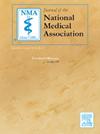优化产前入院护理:评估二维码患者教育对产后避孕率的影响。
IF 2.3
4区 医学
Q1 MEDICINE, GENERAL & INTERNAL
引用次数: 0
摘要
导言:由于美国各地堕胎法的不确定性,产后避孕的重要性增加了,特别是对于需要产前住院治疗的高危妊娠妇女。关于避孕的讨论常常被其他与高危怀孕有关的无数讨论所掩盖。考虑到系统性种族主义和与永久绝育有关的强迫的历史,这对有色人种的生育尤其重要。这个质量改进项目旨在通过实施一种利用技术促进患者教育和讨论避孕的新方法来解决这些问题。方法:将标准化的快速反应(QR)码(Denso Wave Inc ., Kariya, Japan)放置在病房中,并链接到一个详细介绍每种避孕方法的安全性概况和副作用的综合网站。我们的目标是增加产后出院避孕计划的建立。结果:本项目分析了我院产前部在同一次住院期间分娩的孕妇,共分二维码实施前1年(n = 72)和实施后1年(n = 98)两个时间段。实施后,制定节育计划的患者比例明显增加(71.4% vs. 50%, p = 0.006)。值得注意的是,无论是产后绝育(11.1%至16.3%;P = 0.379)或胎盘后放置宫内节育器(1.4% ~ 4.1%; = 0.397页)增加。实施QR教育后选择永久避孕的黑人患者较多(p = 0.016)。结论:该质量改进项目在解决避孕方法方面取得了重大进展,并突出了利用技术加强患者教育和赋权的潜力,特别是在高危妊娠环境中。这一新颖的概念验证强调了解决医疗差距的创新方法的重要性。本文章由计算机程序翻译,如有差异,请以英文原文为准。
Optimizing antepartum admission care: Assessing the influence of QR code-based patient education on postpartum contraception rates
Introduction
With the uncertain landscape of abortion laws across the United States, the importance of postpartum contraception has increased, particularly for women experiencing high-risk pregnancies requiring antepartum hospitalization. Conversations about contraception are often overshadowed by the myriad of other discussions related to high-risk pregnancies. This is especially significant for birthing persons of color, given the history of systemic racism and coercion related to permanent sterilization. This quality improvement project aimed to address these issues by implementing a novel approach using technology to facilitate patient education and discussion about contraception.
Methods
A standardized quick response (QR) code (Denso Wave Inc, Kariya, Japan) was placed in patient rooms, linking to a comprehensive website detailing birth control options, safety profiles, and side effects for each method. Our objective was to increase the establishment of postpartum contraception plans upon discharge.
Results
The project analyzed pregnancies admitted to our institution's antepartum unit, who delivered during the same admission, over 2 periods: 1 year before (n = 72) and 1 year after (n = 98) QR code implementation. Post-implementation, the proportion of patients establishing a birth control plan increased significantly (71.4 % vs. 50 %, p = 0.006). Of note, neither postpartum sterilization (11.1 % to 16.3 %; p = 0.379) or post-placental intrauterine device placement (1.4 % to 4.1 %; p = 0.397) increased. More Black patients chose permanent contraception after QR education implementation (p = 0.016).
Conclusion
This quality improvement project showed significant improvements in addressing contraception methods and highlights the potential of leveraging technology to enhance patient education and empowerment, particularly in high-risk pregnancy settings. This novel proof-of-concept underscores the importance of innovative approaches to address healthcare gaps.
求助全文
通过发布文献求助,成功后即可免费获取论文全文。
去求助
来源期刊
CiteScore
4.80
自引率
3.00%
发文量
139
审稿时长
98 days
期刊介绍:
Journal of the National Medical Association, the official journal of the National Medical Association, is a peer-reviewed publication whose purpose is to address medical care disparities of persons of African descent.
The Journal of the National Medical Association is focused on specialized clinical research activities related to the health problems of African Americans and other minority groups. Special emphasis is placed on the application of medical science to improve the healthcare of underserved populations both in the United States and abroad. The Journal has the following objectives: (1) to expand the base of original peer-reviewed literature and the quality of that research on the topic of minority health; (2) to provide greater dissemination of this research; (3) to offer appropriate and timely recognition of the significant contributions of physicians who serve these populations; and (4) to promote engagement by member and non-member physicians in the overall goals and objectives of the National Medical Association.

 求助内容:
求助内容: 应助结果提醒方式:
应助结果提醒方式:


